A Translational Study of TNF-Alpha Antagonists as an Adjunctive Therapy for Preventing Hemophilic Arthropathy
Abstract
1. Introduction
2. Material and Methods
2.1. Animal Care and Study
2.1.1. Drugs Used in the Study
2.1.2. In Vivo Efficacy of Anti-TNFα in Protecting against Multiple Bleeding-Induced Joint Deterioration in FIX−/− Mice
- “No Treatment”: needle injury only;
- “FIX”: FIX protein was administered after each needle injury;
- “FIX + Anti-TNFα 7”: Besides FIX protein, anti-TNFα treatment was initiated from day 7;
- “FIX + Anti-TNFα 21”: Anti-TNFα treatment was initiated from day 21;
- “FIX + Dex1”: Besides FIX protein after each needle injury, Dex was administered for 5 consecutive days after each needle injury;
- “FIX + Dex2”: Dex was administrated on day 7 every other day for a total 10 doses, a schedule identical to the “FIX + Anti-TNFα7” group;
- “WT injuries”: Hemostatically normal mice subjected to the same injuries and sacrificed at week 6 to serve as the control group.
2.1.3. Histologic Grading
2.1.4. TNFα in Synovial Fluid and Multiplex Cytokine Measurement
2.1.5. Macrophage Immunostaining
2.2. Patient Study
2.2.1. Patient Recruitment
2.2.2. Synovial Fluid Harvesting and Anti-TNFα Administration from Patients with Hemophilia Arthropathy
2.2.3. TNFα Measurement in Plasma and Synovial Fluid
2.2.4. Hemophiliac Synovitis (HS) Assessment and Monitoring
2.3. Statistical Analysis
3. Result
3.1. Hemarthroses Elevated TNFα while Anti-TNFα Decreased TNFα Production in Synovial Fluid
3.2. Anti-TNFα Decreased Joint Deterioration after Multiple Intraarticular Hemorrhage in FIX−/− Mice
3.3. Anti-TNFα Decreased Macrophage Infiltration or Proliferation in the Synovium
3.4. Elevated TNFα in the Synovial Fluid of Patients with Hemophilia
3.5. Intra-Articular Administration of Anti-TNFα Decreased Synovial Thickness and Vascularity in Patients with HA
4. Discussion
Supplementary Materials
Author Contributions
Funding
Acknowledgments
Conflicts of Interest
References
- Simpson, M.L.; Valentino, L.A. Management of joint bleeding in hemophilia. Expert Rev. Hematol. 2012, 5, 459–468. [Google Scholar] [CrossRef] [PubMed]
- Arruda, V.R.; Doshi, B.S.; Samelson-Jones, B.J. Novel approaches to hemophilia therapy: Successes and challenges. Blood 2017, 130, 2251–2256. [Google Scholar] [CrossRef] [PubMed]
- Manco-Johnson, M.J.; Abshire, T.C.; Shapiro, A.D.; Riske, B.; Hacker, M.R.; Kilcoyne, R.; Ingram, J.D.; Manco-Johnson, M.L.; Funk, S.; Jacobson, L.; et al. Prophylaxis versus episodic treatment to prevent joint disease in boys with severe hemophilia. N. Engl. J. Med. 2007, 357, 535–544. [Google Scholar] [CrossRef] [PubMed]
- Fischer, K.; Steen Carlsson, K.; Petrini, P.; Holmström, M.; Ljung, R.; van den Berg, H.M.; Berntorp, E. Intermediate-dose versus high-dose prophylaxis for severe hemophilia: Comparing outcome and costs since the 1970s. Blood 2013, 122, 1129–1136. [Google Scholar] [CrossRef]
- Pulles, A.E.; Mastbergen, S.C.; Schutgens, R.E.; Lafeber, F.P.; van Vulpen, L.F. Pathophysiology of hemophilic arthropathy and potential targets for therapy. Pharmacol. Res. 2017, 115, 192–199. [Google Scholar] [CrossRef]
- Acharya, S.S.; Kaplan, R.N.; Macdonald, D.; Fabiyi, O.T.; DiMichele, D.; Lyden, D. Neoangiogenesis contributes to the development of hemophilic synovitis. Blood 2011, 117, 2484–2493. [Google Scholar] [CrossRef]
- Sen, D.; Chapla, A.; Walter, N.; Daniel, V.; Srivastava, A.; Jayandharan, G.R. Nuclear factor (NF)-kappaB and its associated pathways are major molecular regulators of blood-induced joint damage in a murine model of hemophilia. J. Thromb. Haemost. 2013, 11, 293–306. [Google Scholar] [CrossRef]
- Narkbunnam, N.; Sun, J.; Hu, G.; Lin, F.C.; Bateman, T.A.; Mihara, M.; Monahan, P.E. IL-6 receptor antagonist as adjunctive therapy with clotting factor replacement to protect against bleeding-induced arthropathy in hemophilia. J. Thromb. Haemost. 2013, 11, 881–893. [Google Scholar] [CrossRef]
- Haxaire, C.; Hakobyan, N.; Pannellini, T.; Carballo, C.; McIlwain, D.; Mak, T.W.; Rodeo, S.; Acharya, S.; Li, D.; Szymonifka, J.; et al. Blood-induced bone loss in murine hemophilic arthropathy is prevented by blocking the iRhom2/ADAM17/TNF-alpha pathway. Blood 2018, 132, 1064–1074. [Google Scholar] [CrossRef]
- Van Vulpen, L.F.; Schutgens, R.E.; Coeleveld, K.; Alsema, E.C.; Roosendaal, G.; Mastbergen, S.C.; Lafeber, F.P. IL-1beta, in contrast to TNFalpha, is pivotal in blood-induced cartilage damage and is a potential target for therapy. Blood 2015, 126, 2239–2246. [Google Scholar] [CrossRef]
- Leal, I.; Rodrigues, F.B.; Sousa, D.C.; Romão, V.C.; Duarte, G.S.; Carreño, E.; Dick, A.D.; Marques-Neves, C.; Costa, J.; Fonseca, J.E. Efficacy and safety of intravitreal anti-tumour necrosis factor drugs in adults with non-infectious uveitis—A systematic review. Acta Ophthalmol. 2018, 96, e665–e675. [Google Scholar] [CrossRef] [PubMed]
- Hakobyan, N.; Enockson, C.; Cole, A.A.; Sumner, D.R.; Valentino, L.A. Experimental haemophilic arthropathy in a mouse model of a massive haemarthrosis: Gross, radiological and histological changes. Haemophilia 2008, 14, 804–809. [Google Scholar] [CrossRef] [PubMed]
- Sun, J.; Hakobyan, N.; Valentino, L.A.; Feldman, B.L.; Samulski, R.J.; Monahan, P.E. Intraarticular factor IX protein or gene replacement protects against development of hemophilic synovitis in the absence of circulating factor IX. Blood 2008, 112, 4532–4541. [Google Scholar] [CrossRef] [PubMed]
- Sun, J.; Hua, B.; Livingston, E.W.; Taves, S.; Johansen, P.B.; Hoffman, M.; Ezban, M.; Monroe, D.M.; Bateman, T.A.; Monahan, P.E. Abnormal joint and bone wound healing in hemophilia mice is improved by extending factor IX activity after hemarthrosis. Blood 2017, 129, 2161–2171. [Google Scholar] [CrossRef]
- Valentino, L.A.; Hakobyan, N. Histological changes in murine haemophilic synovitis: A quantitative grading system to assess blood-induced synovitis. Haemophilia 2006, 12, 654–662. [Google Scholar] [CrossRef]
- Hoffman, M.; Harger, A.; Lenkowski, A.; Hedner, U.; Roberts, H.R.; Monroe, D.M. Cutaneous wound healing is impaired in hemophilia B. Blood 2006, 108, 3053–3060. [Google Scholar] [CrossRef]
- Srivastava, A.; Brewer, A.K.; Mauser-Bunschoten, E.P.; Key, N.S.; Kitchen, S.; Llinas, A.; Ludlam, C.A.; Mahlangu, J.N.; Mulder, K.; Poon, M.C.; et al. Guidelines for the management of hemophilia. Haemophilia 2013, 19, e1–e47. [Google Scholar] [CrossRef]
- Naredo, E.; Hinojosa, M.; Valor, L.; Hernández-Flórez, D.; Mata-Martínez, C.; Serrano-Benavente, B.; Del Río, T.; Bello, N.; Montoro, M.; Nieto-González, J.C.; et al. Does ultrasound-scored synovitis depend on the pharmacokinetics of subcutaneous anti-TNF agents in patients with rheumatoid arthritis? Rheumatology 2014, 53, 2088–2094. [Google Scholar] [CrossRef]
- De Rezende, M.U.; Rosa, T.B.; Pasqualin, T.; Frucchi, R.; Okazaki, E.; Villaca, P.R. Subjective results of joint lavage and viscosupplementation in hemophilic arthropathy. Acta Ortop. Bras. 2015, 23, 162–166. [Google Scholar] [CrossRef][Green Version]
- Zhang, F.; Ma, C. Comparison of the effectiveness on intra-articular and subcutaneous TNF inhibitor in rheumatoid arthritis patients. Clin. Rheumatol. 2018, 37, 199–204. [Google Scholar] [CrossRef]
- Martinoli, C.; Della Casa Alberighi, O.; Di Minno, G.; Graziano, E.; Molinari, A.C.; Pasta, G.; Russo, G.; Santagostino, E.; Tagliaferri, A.; Tagliafico, A.; et al. Development and definition of a simplified scanning procedure and scoring method for Haemophilia Early Arthropathy Detection with Ultrasound (HEAD-US). Thromb. Haemost. 2013, 109, 1170–1179. [Google Scholar] [CrossRef] [PubMed]
- Li, J.; Liu, W.; Guo, X.J.; Ding, X.L.; Lyu, B.M.; Xiao, J.; Sun, Q.L.; Li, D.S.; Zhang, W.F.; Zhong, J.C.; et al. HEAD-US-C quantitative ultrasound assessment scale in evaluation of joint damage in patients with moderate or severe hemophilia A received on-demand versus prophylaxis replacement therapy. Zhonghua Xue Ye Xue Za Zhi 2018, 39, 817–821. [Google Scholar] [PubMed]
- Li, J.; Guo, X.J.; Ding, X.L.; Lyu, B.M.; Xiao, J.; Sun, Q.L.; Li, D.S.; Zhang, W.F.; Zhou, J.C.; Li, C.P.; et al. Clinical application and optimization of HEAD-US quantitative ultrasound assessment scale for hemophilic arthropathy. Zhonghua Xue Ye Xue Za Zhi 2018, 39, 132–136. [Google Scholar] [PubMed]
- Naredo, E.; Rodriguez, M.; Campos, C.; Rodríguez-Heredia, J.M.; Medina, J.A.; Giner, E.; Martínez, O.; Toyos, F.J.; Ruíz, T.; Ros, I.; et al. Validity, reproducibility, and responsiveness of a twelve-joint simplified power doppler ultrasonographic assessment of joint inflammation in rheumatoid arthritis. Arthritis Rheum. 2008, 59, 515–522. [Google Scholar] [CrossRef] [PubMed]
- Jansen, N.W.; Roosendaal, G.; Hooiveld, M.J.; Bijlsma, J.W.; van Roon, J.A.; Theobald, M.; Lafeber, F.P. Interleukin-10 protects against blood-induced joint damage. Br. J. Haematol. 2008, 142, 953–961. [Google Scholar] [CrossRef] [PubMed]
- Haxaire, C.; Blobel, C.P. With blood in the joint—What happens next? Could activation of a pro-inflammatory signalling axis leading to iRhom2/TNFalpha-convertase-dependent release of TNFalpha contribute to haemophilic arthropathy? Haemophilia 2014, 20 (Suppl. 4), 11–14. [Google Scholar] [CrossRef]
- Carubbi, F.; Zugaro, L.; Cipriani, P.; Conchiglia, A.; Gregori, L.; Danniballe, C.; Letizia Pistoia, M.; Liakouli, V.; Ruscitti, P.; Ciccia, F.; et al. Safety and efficacy of intra-articular anti-tumor necrosis factor alpha agents compared to corticosteroids in a treat-to-target strategy in patients with inflammatory arthritis and monoarthritis flare. Int. J. Immunopathol. Pharmacol. 2016, 29, 252–266. [Google Scholar] [CrossRef]
- Ovlisen, K.; Kristensen, A.T.; Jensen, A.L.; Tranholm, M. IL-1 beta, IL-6, KC and MCP-1 are elevated in synovial fluid from haemophilic mice with experimentally induced haemarthrosis. Haemophilia 2009, 15, 802–810. [Google Scholar] [CrossRef]
- Melchiorre, D.; Manetti, M.; Matucci-Cerinic, M. Pathophysiology of Hemophilic Arthropathy. J. Clin. Med. 2017, 6, 63. [Google Scholar] [CrossRef]
- Van Vulpen, L.F.D.; Popov-Celeketic, J.; van Meegeren, M.E.R.; Coeleveld, K.; van Laar, J.M.; Hack, C.E.; Schutgens, R.E.G.; Mastbergen, S.C.; Lafeber, F.P.J.G. A fusion protein of interleukin-4 and interleukin-10 protects against blood-induced cartilage damage in vitro and in vivo. J. Thromb. Haemost. 2017, 15, 1788–1798. [Google Scholar] [CrossRef]
- Wojdasiewicz, P.; Poniatowski, L.A.; Nauman, P.; Mandat, T.; Paradowska-Gorycka, A.; Romanowska-Próchnicka, K.; Szukiewicz, D.; Kotela, A.; Kubaszewski, Ł.; Kotela, I.; et al. Cytokines in the pathogenesis of hemophilic arthropathy. Cytokine Growth Factor Rev. 2018, 39, 71–91. [Google Scholar] [CrossRef] [PubMed]
- Bhat, V.; Olmer, M.; Joshi, S.; Durden, D.L.; Cramer, T.J.; Barnes, R.F.; Ball, S.T.; Hughes, T.H.; Silva, M.; Luck, J.V.; et al. Vascular remodeling underlies rebleeding in hemophilic arthropathy. Am. J. Hematol. 2015, 90, 1027–1035. [Google Scholar] [CrossRef] [PubMed]
- Brennan, F.M.; Chantry, D.; Jackson, A.; Maini, R.; Feldmann, M. Inhibitory effect of TNF alpha antibodies on synovial cell interleukin-1 production in rheumatoid arthritis. Lancet 1989, 2, 244–247. [Google Scholar] [CrossRef]
- Tak, P.P.; Taylor, P.C.; Breedveld, F.C.; Smeets, T.J.; Daha, M.R.; Kluin, P.M.; Meinders, A.E.; Maini, R.N. Decrease in cellularity and expression of adhesion molecules by anti-tumor necrosis factor alpha monoclonal antibody treatment in patients with rheumatoid arthritis. Arthritis Rheum. 1996, 39, 1077–1081. [Google Scholar] [CrossRef] [PubMed]
- Taylor, P.C.; Peters, A.M.; Paleolog, E.; Chapman, P.T.; Elliott, M.J.; McCloskey, R.; Feldmann, M.; Maini, R.N. Reduction of chemokine levels and leukocyte traffic to joints by tumor necrosis factor alpha blockade in patients with rheumatoid arthritis. Arthritis Rheum. 2000, 43, 38–47. [Google Scholar] [CrossRef]
- Paleolog, E.M.; Hunt, M.; Elliott, M.J.; Feldmann, M.; Maini, R.N.; Woody, J.N. Deactivation of vascular endothelium by monoclonal anti-tumor necrosis factor alpha antibody in rheumatoid arthritis. Arthritis Rheum. 1996, 39, 1082–1091. [Google Scholar] [CrossRef]
- Manetti, M.; Linari, S.; Romano, E.; Rosa, I.; Carulli, C.; Innocenti, M.; Matucci-Cerinic, M.; Ibba-Manneschi, L.; Castaman, G.; Melchiorre, D. TNF-alpha/TNF-R System May Represent a Crucial Mediator of Proliferative Synovitis in Hemophilia A. J. Clin. Med. 2019, 8, 939. [Google Scholar] [CrossRef]
- Marchand, M.; Monnot, C.; Muller, L.; Germain, S. Extracellular matrix scaffolding in angiogenesis and capillary homeostasis. Semin. Cell Dev. Biol. 2019, 89, 147–156. [Google Scholar] [CrossRef]
- Jung, K.; Lee, D.; Lim, H.S.; Lee, S.I.; Kim, Y.J.; Lee, G.M.; Kim, S.C.; Koh, G.Y. Double anti-angiogenic and anti-inflammatory protein Valpha targeting VEGF-A and TNF-alpha in retinopathy and psoriasis. J. Biol. Chem. 2011, 286, 14410–14418. [Google Scholar] [CrossRef]
- Nieuwenhuizen, L.; Roosendaal, G.; Coeleveld, K.; Lubberts, E.; Biesma, D.H.; Lafeber, F.P.; Schutgens, R.E. Haemarthrosis stimulates the synovial fibrinolytic system in haemophilic mice. Thromb. Haemost. 2013, 110, 173–183. [Google Scholar]
- Nieuwenhuizen, L.; Schutgens, R.E.; Coeleveld, K.; Mastbergen, S.C.; Roosendaal, G.; Biesma, D.H.; Lafeber, F.P. Hemarthrosis in hemophilic mice results in alterations in M1-M2 monocyte/macrophage polarization. Thromb. Res. 2014, 133, 390–395. [Google Scholar] [CrossRef] [PubMed]
- Christensen, K.R.; Kjelgaard-Hansen, M.; Nielsen, L.N.; Wiinberg, B.; Alexander Althoehn, F.; Bloksgaard Poulsen, N.; Kryger Vøls, K.; Popp Thyme, A.; Maria Lövgren, K.; Kornerup Hansen, A.; et al. Rapid inflammation and early degeneration of bone and cartilage revealed in a time-course study of induced haemarthrosis in haemophilic rats. Rheumatology 2019, 58, 588–599. [Google Scholar] [CrossRef] [PubMed]
- Van Meegeren, M.E.; Roosendaal, G.; Coeleveld, K.; Nieuwenhuizen, L.; Mastbergen, S.C.; Lafeber, F.P. A single intra-articular injection with IL-4 plus IL-10 ameliorates blood-induced cartilage degeneration in haemophilic mice. Br. J. Haematol. 2013, 160, 515–520. [Google Scholar] [CrossRef] [PubMed]
- Van Meegeren, M.E.; Roosendaal, G.; Jansen, N.W.; Wenting, M.J.; van Wesel, A.C.; van Roon, J.A.; Lafeber, F.P. IL-4 alone and in combination with IL-10 protects against blood-induced cartilage damage. Osteoarthr. Cartil. 2012, 20, 764–772. [Google Scholar] [CrossRef]
- Van Meegeren, M.E.; Roosendaal, G.; van Veghel, K.; Mastbergen, S.C.; Lafeber, F.P. A short time window to profit from protection of blood-induced cartilage damage by IL-4 plus IL-10. Rheumatology 2013, 52, 1563–1571. [Google Scholar] [CrossRef]
- Melchiorre, D.; Morfini, M.; Linari, S.; Zignego, A.L.; Innocenti, M.; Matucci Cerinic, M. Anti-TNF-alpha therapy prevents the recurrence of joint bleeding in haemophilia and arthritis. Rheumatology 2014, 53, 576–578. [Google Scholar] [CrossRef]
- Kisker, C.T.; Burke, C. Double-blind studies on the use of steroids in the treatment of acute hemarthrosis in patients with hemophilia. N. Engl. J. Med. 1970, 282, 639–642. [Google Scholar] [CrossRef]
- Lovgren, K.M.; Sondergaard, H.; Skov, S.; Wiinberg, B. Non-genetic risk factors in haemophilia A inhibitor management—The danger theory and the use of animal models. Haemophilia 2016, 22, 657–666. [Google Scholar] [CrossRef]
 Represented injury;
Represented injury;  FIX protein treatment. (B): Synovitis score based on the murine synovitis grading system (n ≥ 7/group). (C): Representative histopathological images are shown. ** p < 0.01.
FIX protein treatment. (B): Synovitis score based on the murine synovitis grading system (n ≥ 7/group). (C): Representative histopathological images are shown. ** p < 0.01.
 Represented injury;
Represented injury;  FIX protein treatment. (B): Synovitis score based on the murine synovitis grading system (n ≥ 7/group). (C): Representative histopathological images are shown. ** p < 0.01.
FIX protein treatment. (B): Synovitis score based on the murine synovitis grading system (n ≥ 7/group). (C): Representative histopathological images are shown. ** p < 0.01.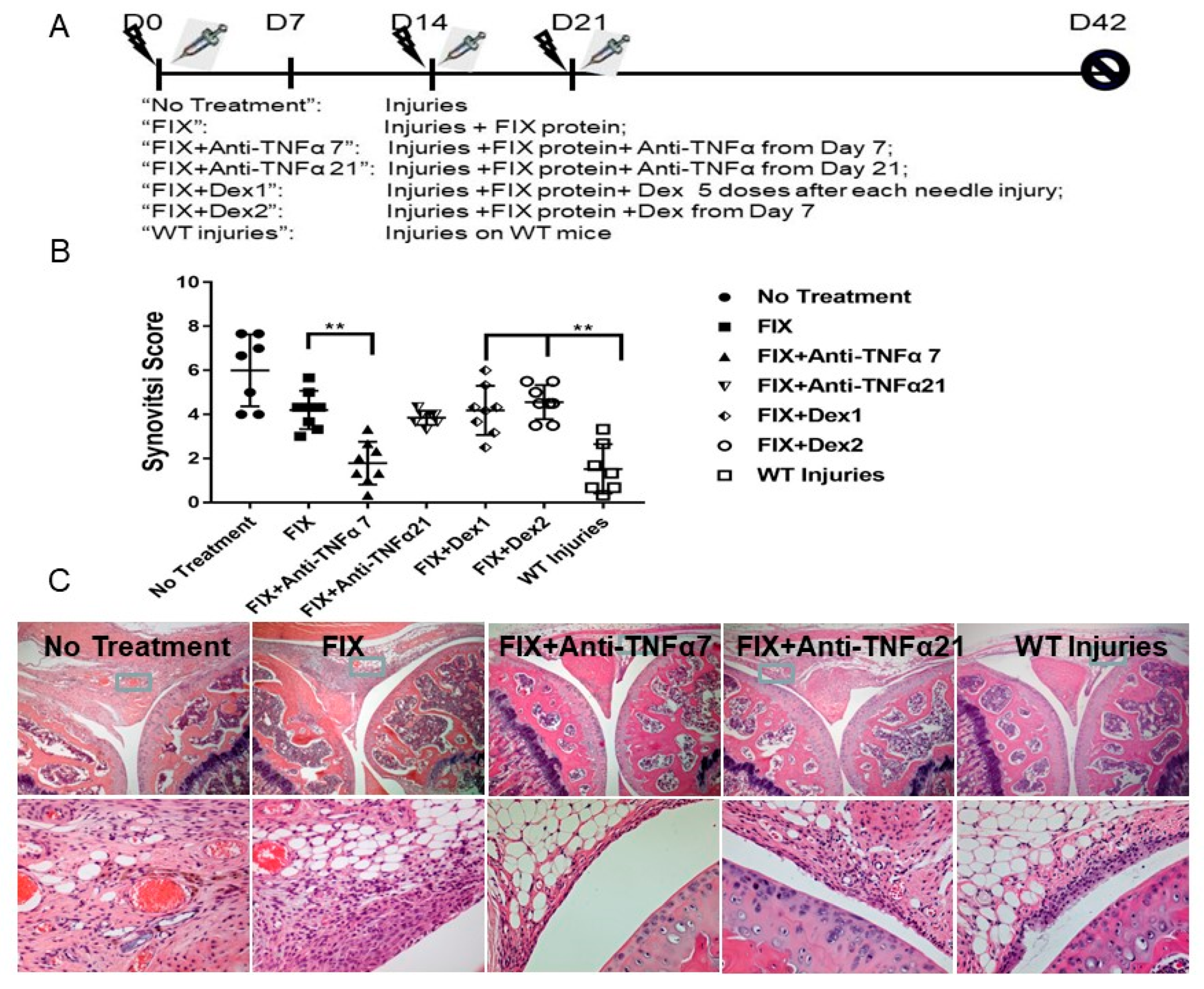
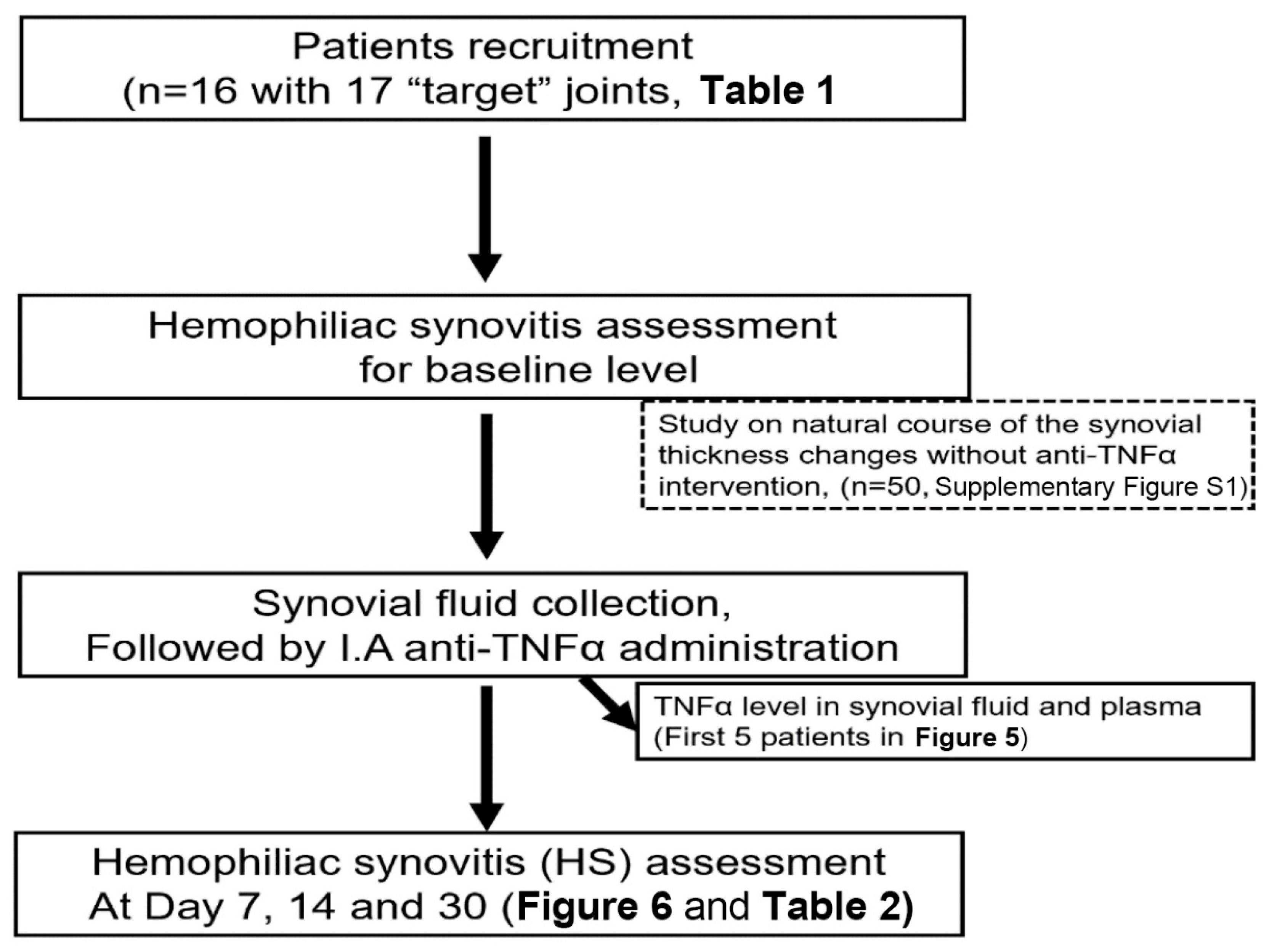
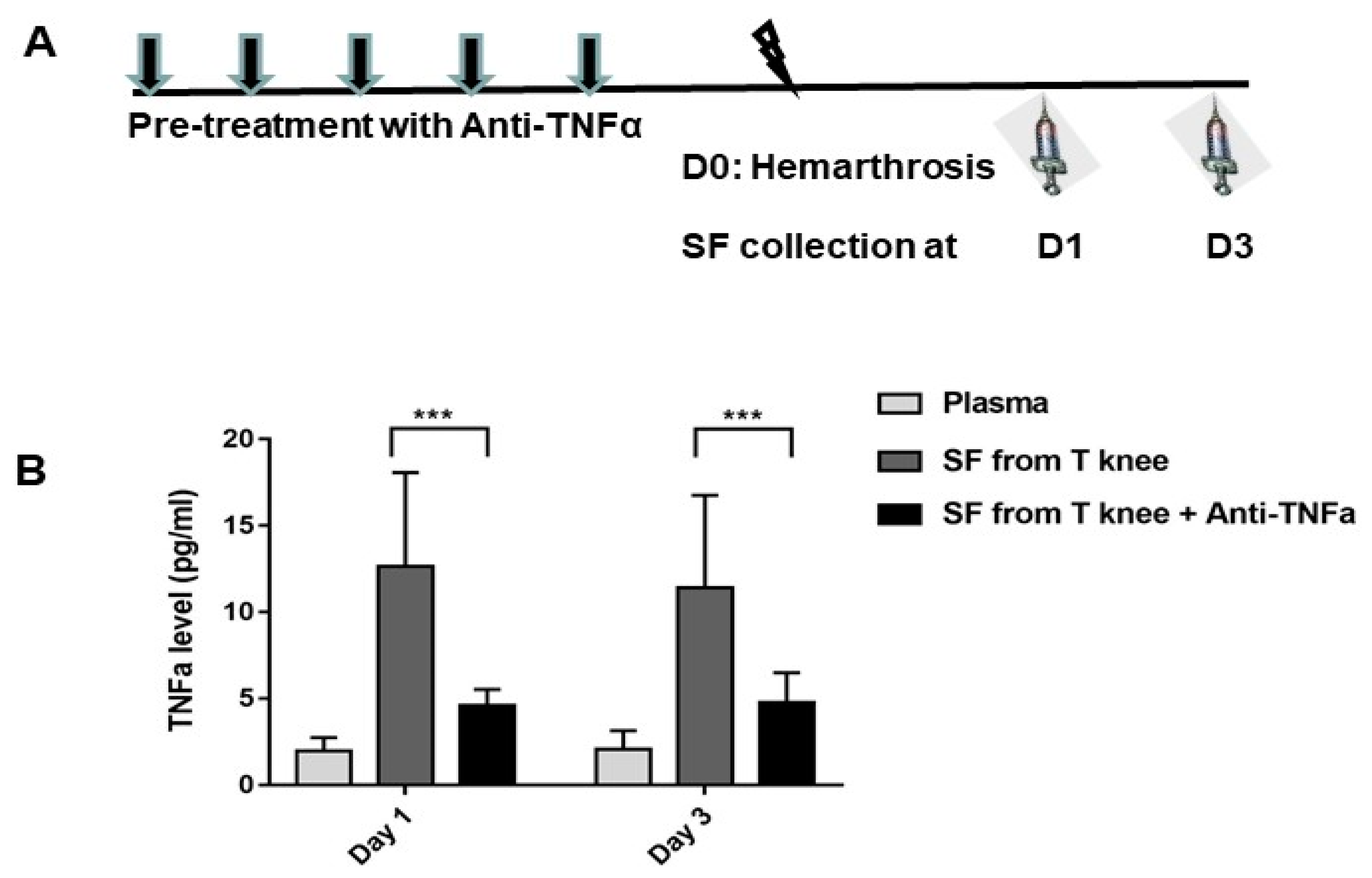

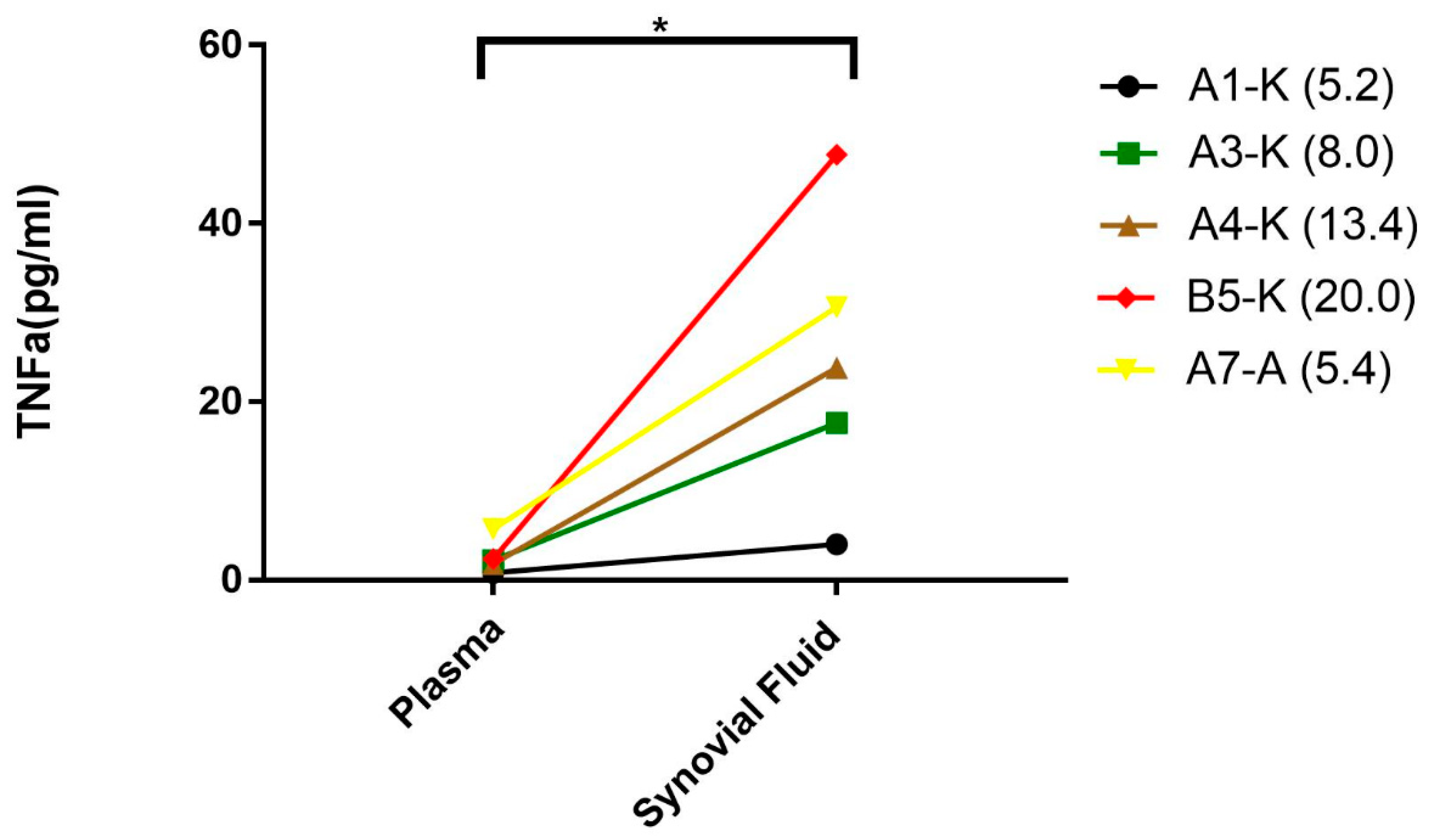
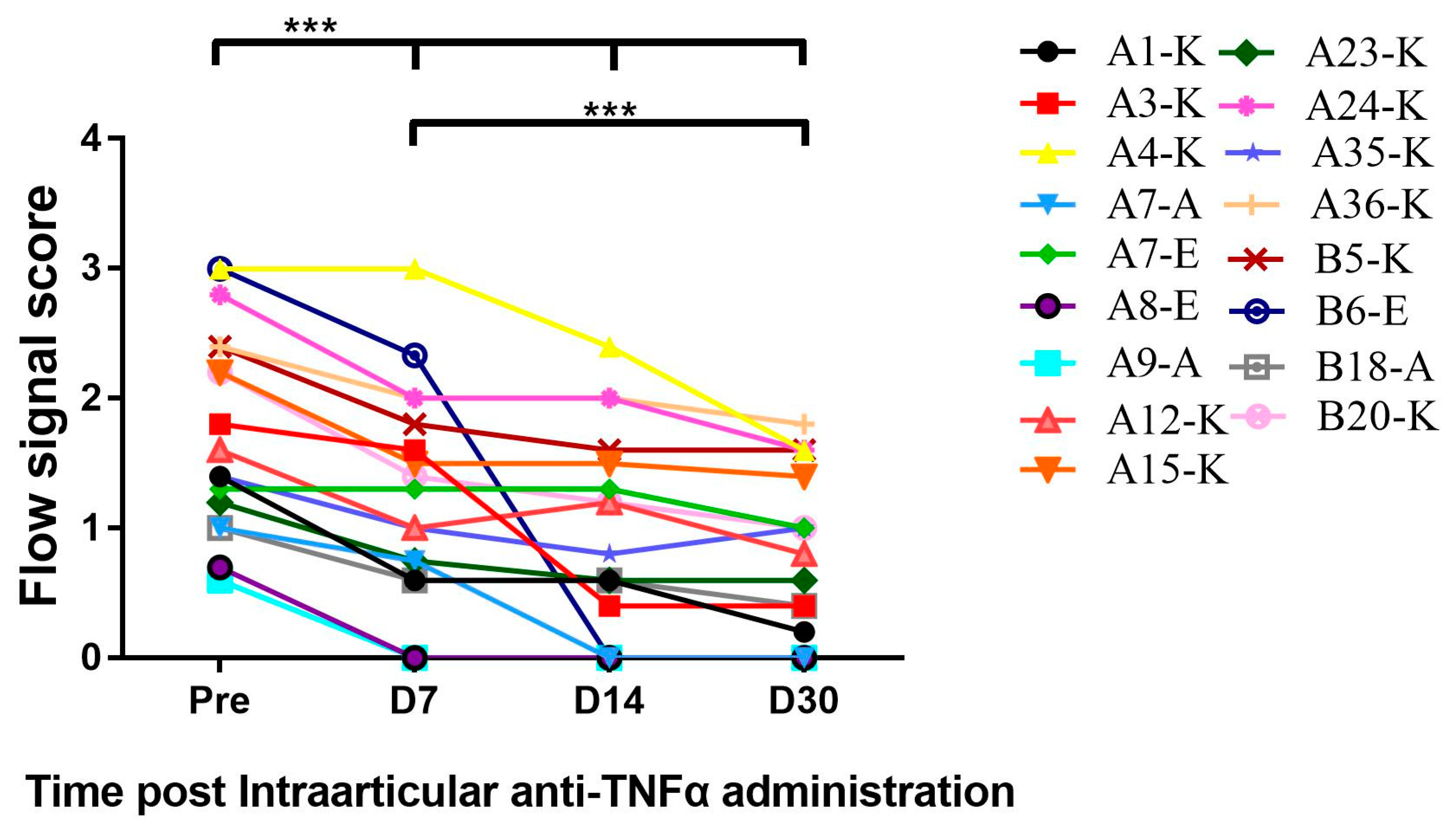
| 8 | Age (Year) | Type | FVIII:C/IX | Target Joint/Nomenclature | AJBR 6 Months Before I.A Injection | Treatment |
|---|---|---|---|---|---|---|
| % | Times | |||||
| A1 | 30 | HA | <1% | RK (A1-K) | 8 | OD |
| A3 | 20 | HA | <1% | RK (A3-K) | 11 | OD |
| A4 | 28 | HA | <1% | LK (A4-K) | 15 | OD |
| A7 | 22 | HA | 1% | LA (A7-A) | 10 | OD |
| RE (A7-E) | 8 | |||||
| A8 | 13 | HA | <1% | RE (A8-E) | 7 | Pro (600U, 3/week) |
| A9 | 16 | HA | <1% | RA (A9-A) | 6 | OD |
| A12 | 26 | HA | 1% | LK (A12-K) | 20 | OD |
| A15 | 25 | HA | <1% | LK (A15-K) | 18 | Pro (400U 2/week) |
| A23 | 18 | HA | 1.1% | RK (A23-K) | 10 | Pro (1000U, 3/week) |
| A24 | 16 | HA | <1% | LK (A24-K) | 16 | OD |
| A35 | 38 | HA | <1% | LK (A35-K) | 8 | OD |
| A36 | 43 | HA | <1% | LK (A36-K) | 12 | OD |
| B5 | 24 | HB | <1% | LK (B5-K) | 13 | OD |
| B6 | 30 | HB | <1% | LE (B6-E) | 9 | OD |
| B18 | 22 | HB | 1.5% | LA (B18-A) | 4 | Pro (PCC 1000IU, q5d) |
| B20 | 25 | HB | <1% | RK (B20-K) | 8 | OD |
| Target Joint ID | Synovial Thickness in Area with Maximum Change (mm (−%)) | Mean Synovial Thickness of All Evaluated Areas (mm) | Range of Synovial Thickness in All Evaluated Areas (mm) | |||||||||
|---|---|---|---|---|---|---|---|---|---|---|---|---|
| Pre- | D7 | D14 | D30 | Pre- | D7 | D14 | D30 | Pre- | D7 | D14 | D30 | |
| A1-K | 11 | 3.9 (−64.5) | 3.6 (−67.3) | 3.4 (−69.1) | 6.06 | 4.16 | 4.06 | 3.72 | 4.2–11.0 | 2.5–6.1 | 2.1–5.2 | 3.4–4.2 |
| A3-K | 4.9 | 3.5 (−28.6) | 2.1 (−57.0) | 1.5 (−69.4) | 5.04 | 4.14 | 3.68 | 3.36 | 3.6–7.8 | 3.1–5.8 | 2.1–5.2 | 1.5–5.0 |
| A4-K | 25 | 16 (−36.0) | 12 (−52.0) | 10 (−60.0) | 14.66 | 11.04 | 8.12 | 8.08 | 7.8–25 | 6.6–16.0 | 4.6–14.0 | 3.7–10.4 |
| A7-A | 8.5 | 5.5 (−35.3) | 4.9 (−42.4) | 4.9 (−42.4) | 6.35 | 5.57 | 4.9 | 4.13 | 3.7–8.5 | 3.6–7.9 | 3.2–6.2 | 3.0–4.9 |
| A7-E | 18.3 | 15.4 (−15.8) | 8.4 (−54.1) | 8 (−56.3) | 8.8 | 7.9 | 6.1 | 6 | 3.8–18.3 | 3.5–15.4 | 3.4–8.4 | 3.4–8.0 |
| A8-E | 7.5 | 4.5 (−40.0) | 3.7 (−50.7) | 3.7 (−50.7) | 9 | 6.43 | 4.73 | 4.7 | 6.4–13.1 | 4.1–10.7 | 3.7–6.7 | 3.7–6.5 |
| A9-A | 13 | NA (NA) | 10.7 (−17.7) | 8.8 (−32.3) | 8.13 | NA | 5.06 | 7.56 | 4.6–13.0 | NA | 2.8–10.7 | 3.9–10.0 |
| A12-K | 11 | 6.8 (−38.2) | 7.2 (−34.5) | 7.4 (−32.7) | 7.78 | 6.5 | 5.8 | 6.38 | 5.0–11.0 | 4.7–10.3 | 4.8–11.2 | 4.4–8.4 |
| A15-K | 16.2 | 14.2 (−12.3) | 9.4 (−42.0) | 10.8 (−33.3) | 13.24 | 11.2 | 9.8 | 10.14 | 9.9–16.2 | 6.4–15.8 | 5.9–14.8 | 7.5–11.0 |
| A23-K | 16.9 | 7.4 (−56.2) | 7.8 (−53.8) | 5.8 (−65.7) | 12.1 | 8.4 | 9.36 | 7.8 | 7.3–16.9 | 6.7–15.4 | 6.4–12.9 | 5.5–10.8 |
| A24-K | 12 | 10.4 (−13.3) | 5.9 (−50.8) | 6.5 (−45.8) | 12.82 | 9.4 | 7.9 | 8.38 | 11.9–13.8 | 6.6–13.2 | 5.9–13.5 | 6.5–10.2 |
| A35-K | 10.3 | 7.9 (−23.3) | 7.1 (−31.1) | 7.5 (−27.2) | 9.88 | 8.68 | 8.04 | 8.32 | 6.2–12.7 | 4.7–10.8 | 4.9–11.2 | 5–10.9 |
| A36-K | 13 | 6.9 (−46.9) | 6.4 (−50.8) | 7.4 (−43.1) | 9.3 | 8.4 | 8.2 | 8 | 5.5–13 | 5.1–10.5 | 4.9–11.1 | 5.5–10.2 |
| B5-K | 17.1 | 9.1 (−46.8) | 6.1 (−64.3) | 5.8 (−66.1) | 16.74 | 12.7 | 9.6 | 8.68 | 13.5–18 | 9.1–16.9 | 6.0–15.7 | 5.8–11.8 |
| B6-E | 19.2 | 12.5 (−34.9) | 8.8 (−54.2) | 9.7 (−49.5) | 15 | 12 | 10.3 | 10.4 | 8.8–19.2 | 9.5–14.0 | 8.3–13.8 | 8.3–13.0 |
| B18-A | 6.4 | 5.7 (−10.9) | 5.5 (−14.1) | 3.7 (−42.2) | 5.23 | NA | 4.3 | 3.46 | 4.6–6.4 | NA | 3.4–5.0 | 3.2–3.7 |
| B20-K | 14.4 | 10.4 (−27.8) | 6.7 (−53.5) | 6.4 (−55.6) | 12.4 | 12.2 | 8.9 | 8.4 | 7.9–16.4 | 7.5–17.6 | 7.9–13.4 | 8.4–14.1 |
© 2019 by the authors. Licensee MDPI, Basel, Switzerland. This article is an open access article distributed under the terms and conditions of the Creative Commons Attribution (CC BY) license (http://creativecommons.org/licenses/by/4.0/).
Share and Cite
Zhang, F.; Xu, M.; Yang, Q.; Hua, B.; Xia, B.; Lin, Z.; Xiao, X.; Monahan, P.E.; Sun, J. A Translational Study of TNF-Alpha Antagonists as an Adjunctive Therapy for Preventing Hemophilic Arthropathy. J. Clin. Med. 2020, 9, 75. https://doi.org/10.3390/jcm9010075
Zhang F, Xu M, Yang Q, Hua B, Xia B, Lin Z, Xiao X, Monahan PE, Sun J. A Translational Study of TNF-Alpha Antagonists as an Adjunctive Therapy for Preventing Hemophilic Arthropathy. Journal of Clinical Medicine. 2020; 9(1):75. https://doi.org/10.3390/jcm9010075
Chicago/Turabian StyleZhang, Feixu, Mengyang Xu, Qin Yang, Baolai Hua, Binglan Xia, Zhenyang Lin, Xiao Xiao, Paul E. Monahan, and Junjiang Sun. 2020. "A Translational Study of TNF-Alpha Antagonists as an Adjunctive Therapy for Preventing Hemophilic Arthropathy" Journal of Clinical Medicine 9, no. 1: 75. https://doi.org/10.3390/jcm9010075
APA StyleZhang, F., Xu, M., Yang, Q., Hua, B., Xia, B., Lin, Z., Xiao, X., Monahan, P. E., & Sun, J. (2020). A Translational Study of TNF-Alpha Antagonists as an Adjunctive Therapy for Preventing Hemophilic Arthropathy. Journal of Clinical Medicine, 9(1), 75. https://doi.org/10.3390/jcm9010075





